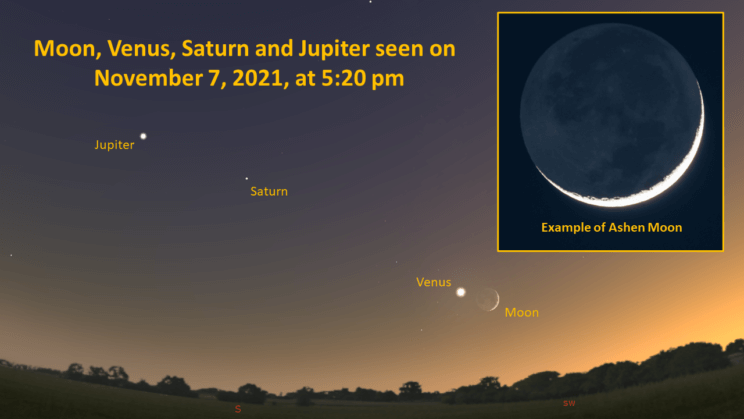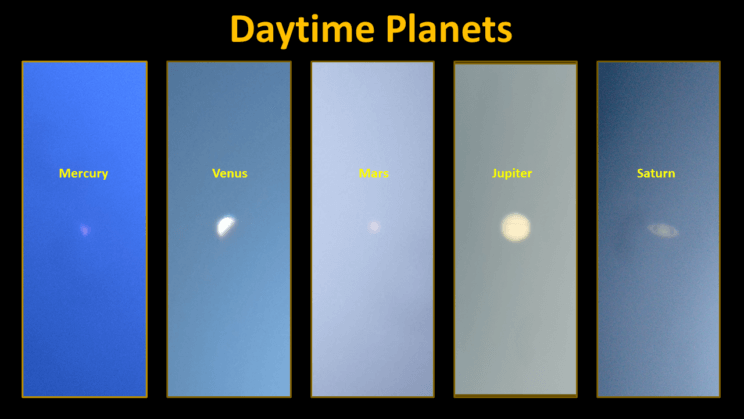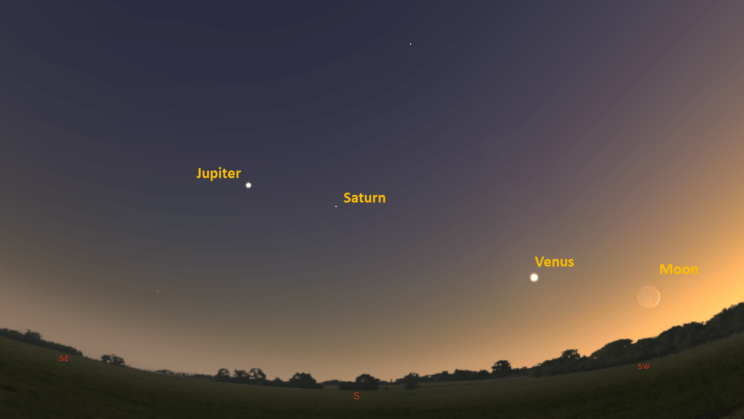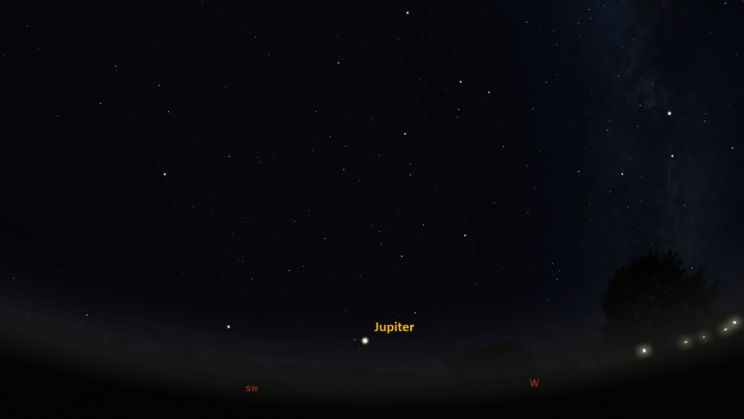This is the Saint Louis Science Center’s NIGHT SKY UPDATE for the week of Friday, November 5, 2021.
Information updated weekly or as needed.
Times given as local St. Louis time which is Central Daylight Time (CDT) until November 7, 2021. This date is when Daylight Saving Time ends, and we revert back to Central Standard Time (CST). For definitions of terminology used in the night sky update, click the highlighted text. If relying on times posted in Universal Time (UT), St. louis is -5 hours when CDT and -6 hours when CST.
Public Telescope Viewings
With the changing recommendations from the CDC regarding COVID-19, conversations regarding the return of star parties at the Saint Louis Science Center have begun. We are close to bringing back our public telescope viewings, but a few details still need to be worked out. We will post future updates as we learn more about when we can bring back telescope viewings.
Observing Highlight of the Week

The Moon, Venus, Saturn and Jupiter seen on November 7, 2021, at 5:20 pm. Graphic created using Stellarium.
This week the Moon and Venus make a nice pair on November 7 and 8. Long ago, humanity discovered that objects like the Sun, Moon and planets moved in ways that were predictable. The predictability of these objects led to the several developments such as time keeping, calendars and the discovery of our solar system. This week we can watch as the Moon first slides by Venus and ends the week as it passes by Saturn and then Jupiter. Every month, the Moon can be seen to pass by each of the planets as it completes its cycle of phases.
On November 7, you will find the Moon and Venus in the south southwestern sky 15 minutes after sunset. The pair will be seen about 4° apart with Venus appearing east of the Moon. If you have binoculars, you will find that like the Moon, Venus exhibits phases. Moon phases occur because the Moon orbits the Earth. As the Moon orbits Earth, the side we see has more of its surface illuminated by the Sun each day. This continues up to full moon when each day after we see less of the surface reflecting sunlight. This is the waxing and waning behavior of the Moon. Venus exhibits phases because it is closer to the Sun. We see Venus exhibit gibbous, quarter and crescent phases but never a full phase. The only time a fully illuminated disk of Venus is presented towards Earth occurs at superior conjunction. This is when Venus appears on the other side of the Sun and is lost in the Sun’s glare. When Venus is visible at night, a telescope will always reveal its phases. During crescent phases, binoculars are enough to spot the phase of Venus. This will be the case for the rest of this year as Venus heads towards inferior conjunction on January 8, 2022.
On November 8, you will see the Moon east of Venus, and the pair will appear roughly 10° apart. Each day, the Moon moves about 14° across the sky. In 29.5 days, the Moon completes its cycle of phases. If you track this through the month, you will see the Moon pass through each of the Zodiac constellations. On November 10, the Moon will be near Saturn, and on November 11, it will be near Jupiter.
Something else to look for this week is called Ashen Moon. Also known as Earthshine, when exhibiting crescent phases, you can dimly see the portions of the Moon still in darkness. This happens because sunlight reflecting off Earth dimly illuminates the lunar surface. The opposite happens when the Moon is near full moon. Sunlight reflecting off the Moon dimly illuminates the night side of Earth. The next full moon occurs on November 19. If you go outside as night falls on November 18, a near-full moon will be found rising in the east. As it climbs overhead, you might be surprised how bright things become. Keep in mind that just after midnight a lunar eclipse begins at 12:02 a.m. and ends at 6:03 a.m. The brightness of the Moon will drastically change as it passes into Earth’s shadow. A lunar eclipse is the only time the Moon passes through Earth’s shadow. This is only possible at full moon.
Daytime Planets

The five naked eye planets seen in the daytime.
Credit: Eric Gustafson
Back in 2020, when much of the world found they had a little extra free time, I decided to explore the possibility of viewing planets in the daytime. The impetus for this was then the upcoming great conjunction of Jupiter and Saturn on December 21, 2020. Jupiter and Saturn reach conjunction every 20 years, and the 2020 conjunction was a particularly good one. The only downside was for us in St. Louis, the two planets appeared their closest in the daytime. So, I wanted to see what planets could be seen during the day.
Be aware that daytime viewing of planets can be dangerous because planets often appear close to the Sun. Looking directly at the Sun without optical aid can cause vision loss. To see planets in the daytime you need to use binoculars or a telescope. If you accidentally point them at the Sun, it WILL damage your eyes. Because of the inherent danger associated with daytime planet viewing, I would not recommend this to someone just learning to observe.
All observations mentioned after this were done using a 9.25” SCT telescope with a 12.5mm eyepiece. All images were captured using afocal imaging with a cellphone mounted to the eye piece.
I knew Venus would be visible, but I guessed the other naked eye planets might be visible as well. After Venus, Jupiter is the easiest planet to see in the daytime. Three hours after sunrise I could still see cloud details in the Jovian atmosphere. Saturn was tough to find but once found the rings were dimly visible in the daytime. Mars was surprising easy to see, likely because its red color contrasted well with the blue sky. And finally, Mercury was a bust. After not seeing Mercury I checked various observing forums, and some did mention Mercury as visible in the daytime, but it remained an elusive daytime target for me until November 2, 2021.
The key to spotting the naked eye planets in the daytime is knowledge of their orbits. This seems like an obvious statement, as knowing an object’s location is key to finding anything. That said, if you understand key terms related to a planet’s orbit such as opposition and superior or inferior conjunction, you will understand when something appears brighter or what you should see when observing it. For Mercury, the elusive planet is brightest when it exhibits a gibbous phase. This occurs before and after superior conjunction. Mercury is currently headed towards superior conjunction on November 28. The last time I tried Mercury in daytime was when it was headed toward inferior conjunction.
The main reason I decided to try Mercury again was because the Moon was set to occult Mercury on November 3. An occultation occurs when one object is hidden by another when it passes between it and the observer. In St. Louis, the occultation started around 2.39 p.m., which meant it had to be viewed in the daytime. As the occultation approached, what was most surprising was the Moon was not visible. It was less than a day away from new moon, but I still expected to see a bit of a thin waning crescent. I was able to capture Mercury disappearing behind the Moon.
The video below shows the occultation of Mercury on November 3. The dancing view of Mercury occurred because of atmospheric distortions. The twinkling of stars is a great example of this. Similarly, planets can appear to waver when viewed through a telescope. The magnitude of the distortion is dependent on atmospheric conditions. When visible, lunar occultations are only visible from a small part of the Earth. Much like you had to be in the right place to see the total solar eclipse in 2017, this lunar occultation was only visible from Canada, parts of the US and Bermuda. There are several resources available if you are interested in learning about these types of astronomical events. One of my go-to resources is the RASC publishes the Observer’s Handbook. Published annually, they document observing information for each year such as the lunar occultation of Mercury on November 3, 2021.
Lastly, once I spotted Mercury with a telescope, I tried binoculars. This time, Mercury was bright enough that I was able to find it with 7×42 binoculars. Backyard astronomy offers a multitude of things to look for beyond what is normally considered. If you do find an interest in daytime astronomy, make sure to use caution and never look directly at the Sun.
November 3, 2021 Mercury Occultation
Lunar Occultation of Mercury on November 3, 2021. Credit: Eric Gustafson
The Sun and Moon

The Moon as seen from the International Space Station, on July 31, 2011.
Credit: NASA
Sunrise is at 7:32 a.m. on Friday, November 5 and sunset is at 5:56 p.m. providing us with about 10 hours and 20 minutes of daylight. Even after sunset, the light from the Sun will dimly illuminate our sky for roughly 1 hour and 30 minutes. This period is called twilight, which ends around 7:34 p.m. this week. For those with a sundial, local noon occurs around 12:44 p.m. this week.
| Day | Sunrise | Sunset |
|---|---|---|
| 2021-11-05 | 7:32 a.m. | 5:56 p.m. |
| 2021-11-06 | 7:33 a.m. | 5:55 p.m. |
| 2021-11-07 | 6:34 a.m. | 4:54 p.m. |
| 2021-11-08 | 6:35 a.m. | 4:53 p.m. |
| 2021-11-09 | 6:36 a.m. | 4:52 p.m. |
| 2021-11-10 | 6:38 a.m. | 4:51 p.m. |
| 2021-11-11 | 6:39 a.m. | 4:50 p.m. |
| 2021-11-12 | 6:40 a.m. | 4:50 p.m. |
| 2021-11-13 | 6:41 a.m. | 4:49 p.m. |
Moon
Moonrise for Friday, November 5 occurred at 8:23 a.m. and moonset will occur at 6:40 p.m. On Friday, November 5 the Moon will exhibit a waxing crescent phase with about 2% of the lunar disk illuminated. First quarter moon occurs on November 11 at 6:46 p.m.
International Space Station (ISS) Observing

Visible passes of ISS from St. Louis for the week of November 5 occur during morning hours. The best passes this week occurs on the mornings of November 7, 9 and 10. Use the table below for information about these and other visible passes this week.
Catch ISS from St. Louis starting Friday, November 5
| Date | Starts | Max. altitude | Ends | |||||||
|---|---|---|---|---|---|---|---|---|---|---|
| Time | Alt. | Az. | Time | Alt. | Az. | Time | Alt. | Az. | ||
| 07 Nov | -3.3 | 05:32:05 | 16 | NW | 05:34:36 | 57 | NE | 05:37:54 | 10 | ESE |
| 08 Nov | -2.6 | 04:46:51 | 34 | NNE | 04:47:07 | 35 | NNE | 04:50:14 | 10 | E |
| 09 Nov | -0.5 | 04:01:41 | 14 | ENE | 04:01:41 | 14 | ENE | 04:02:21 | 10 | E |
| 09 Nov | -3.2 | 05:34:41 | 22 | WNW | 05:36:28 | 43 | SW | 05:39:40 | 10 | SSE |
| 10 Nov | -3.4 | 04:49:36 | 60 | SSE | 04:49:36 | 60 | SSE | 04:52:26 | 10 | SE |
| 11 Nov | -1.7 | 05:37:35 | 13 | WSW | 05:38:03 | 14 | SW | 05:39:50 | 10 | SSW |
| 12 Nov | -1.4 | 04:52:38 | 15 | S | 04:52:38 | 15 | S | 04:53:30 | 10 | S |
Magnitude (Mag): The Measure of brightness for a celestial object. The lower the value is, the brighter the object will be.
Altitude (Alt): The angle of a celestial object measured upwards from the observer’s horizon.
Azimuth (Az): The direction of a celestial object, measured clockwise from an observer’s location with north being 0°, east being 90°, south being 180° and west being 270°.
For information about ISS flyovers and other visible satellites, visit www.heavens-above.com
Detailed information regarding all unmanned exploration of our universe, missions past, present, and planned, can be found at Jet Propulsion Laboratories:
The Visible Planets

Looking South, at 6:15 p.m. November 6, 2021. Credit: Stellarium, EG

Looking southwest, at 12:00 am, November 7, 2021. Credit: Stellarium, EG
This week, three naked eye planets are visible. Venus can be found in the south southwest after sunset. Jupiter and Saturn can be found in the southeast after sunset.
Venus
Venus is well into another evening apparition. By 6:15 p.m., Venus will be about 16° above the south southwestern horizon. Venus will set at 8:23 p.m. Venus reached maximum eastern elongation October 29, 2021. Venus is now headed back towards the Sun as it approaches inferior conjunction on January 8, 2022.
Mars
The red planet has not been visible for several weeks now. The previous apparition of Mars has ended. But for those itching to see Mars again, you are in luck as the next apparition of Mars begins in November 2021. Mars will climb out of the Sun’s glare eventually becoming visible just before sunrise. The next Mars apparition is expected to begin around November 14, 2021, when Mars will appear far enough from the Sun for safe viewing.
Jupiter
Jupiter has passed opposition and as such will be visible about 30 minutes after sunset. Look for Jupiter in the south as it starts to darken outside. Jupiter sets at 12:47 a.m. tomorrow morning and will set about 30 minutes earlier each week. Jupiter reaches superior conjunction on March 5, 2022. This means we can count on seeing Jupiter in the southern skies for the rest of this year and well into 2022.
Saturn
Saturn is past opposition which means it will be visible about 30 minutes after sunset. Right now, it can be found in the south after sunset, but as we continue through the year, Saturn will set about 30 minutes earlier each night. Saturn sets at 11:29 p.m. Saturn will reach superior conjunction on February 4, 2022.
James S. McDonnell Planetarium
Night Sky Update: November 5 – November 13, 2021






